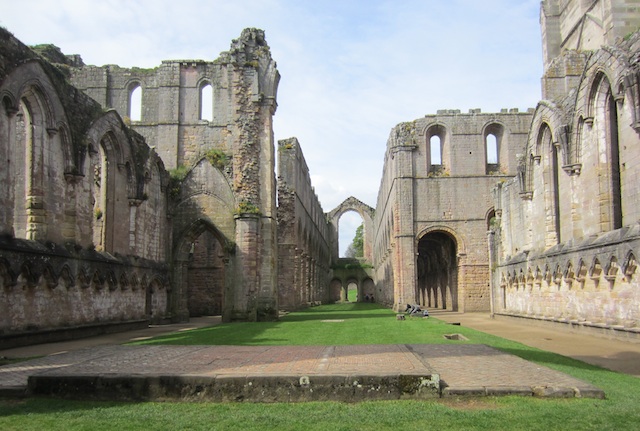Back in 1132, some of the monks at
St. Mary's Benedictine Abbey in York were dissatisfied with the loose lifestyle led at the abbey. Clothing, food, and behavior there did not follow the strict rules laid down by
St. Benedict in his
Rule. A riot broke out in the abbey and thirteen monks fled to the archbishop's residence in Ripon. He granted them some land nearby in the valley of the River Skell. They founded their new monastery,
Fountains Abbey, on December 27 of that year.
The first year was extremely hard and the group asked the Abbot of Clairvaux,
Bernard, for help. Clairvaux was a
Cistercian abbey with the strict discipline and simple lifestyle that the monks longed for. Like many monasteries in England, this humble beginning grew into a grand complex. The abbey was quite wealthy in the 1200s but debts, sheep disease (they owned several farms in the area), Scottish raiders, and the
Black Death all took their toll. A revival happened in the late 1400s, when thrifty and clever abbots were able to reform their lives and restore their prosperity. In 1539 things came to a halt when
Henry VIII seized the property, ending 400 years of worship.
The abbey was sold to a London merchant who stripped all the valuables (including the lead roof and the stained glass) and rented the land out to tenant farmers. The stones from the walls were sold off piecemeal for other building projects in the area. An estate house,
Fountains Hall, was built on the land at the end of the 1500s. The ruins of the abbey were never refurbished. The property passed through several hands until it was purchased by the
National Trust in 1983.
Visiting now, most of the structure is readily visible.
 |
| Fountains Abbey |
 |
| More of the abbey |
The nave is large and now empty. Formerly, the laybrothers would attend prayers and Mass here. The laybrothers did much of the physical work at the abbey, tending the farms and sheep and keeping up the daily tasks of the abbey. The choir monks spent most of their days in silence except when praying the
Divine Office (which happened seven times a day). They worshiped at the front of the nave in the area now known as the Chapel of Nine Altars.
 |
| Entering through the transept (in between the nave and the chapel of nine altars) |
 |
| The chapel area |
 |
| L in the chapel area |
 |
| J on a pedestal |
 |
| The nave |
The tower was added in 1500 by
Abbot Marmaduke Huby and rises 167 feet into the air.
 |
| External view of Huby's Tower |
 |
| Inside Huby's Tower |
 |
| L finds a locked door |
Adjacent to the church is the cloister, a small open field that had a covered walkway around the perimeter that led to various other rooms and buildings of the abbey. The most important room was the chapter house, where the monks gathered to hear Benedict's Rule read and to discuss the business of the abbey.
 |
| The cloister |
 |
| L resting |
 |
| View from the cloister walls |
 |
| On the cloister walls |
 |
| J in the Chapter House |
 |
| L in the same |
Next the to chapter house was the Warming Room, the only room in the monk's part of the abbey with a fireplace. Fires burned from November through Easter. The monks were discouraged from lingering there--they'd just stop between duties to get a little warmer.
 |
| Warming room fireplaces |
The outside wall had the laybrothers' refectory, where they ate their meals. The guesthouses stood beyond the wall. These were for lay travelers who visited the abbey either as their destination or as a stop along their journey.
 |
| Wall by the laybrothers' refectory |
 |
| Outside of the wall |
 |
| The guesthouses |
 |
| Another view of the guesthouses |
The River Skell runs right by the abbey and it was used to power their mill as well as provide sanitation. The toilets as well as the infirmary were on the river side of the abbey. It was perhaps unpleasant to be just down stream from the abbey.
 |
| Water diverted for the toilets |
 |
| By the infirmary |
 |
| View from the infirmary |
 |
| Water returning to the river |
 |
| L relaxing in what's left of the infirmary |
Back under the laybrothers refectory is the cellarium, where goods were stored by the monks. The room is quite large, with two aisles. Many functions are held here nowadays, including the annual Catholic Mass on the feast of St. Benedict and concerts in the summer.
 |
| Cellarium inner aisle |
 |
| Cellarium outer aisle |
The abbey has plenty of twists and turns to explore. Since it's a ruins, it's perfect for children to explore (though it may not be up to American safety standards).
 |
| They found a staircase! |
 |
| In one of the rooms |
 |
| In the big house! |
 |
| A hallway |
 |
| A monk's cell? |
 |
| Map of the abbey (click to enlarge) |
 |
| Model of the abbey |






































No comments:
Post a Comment